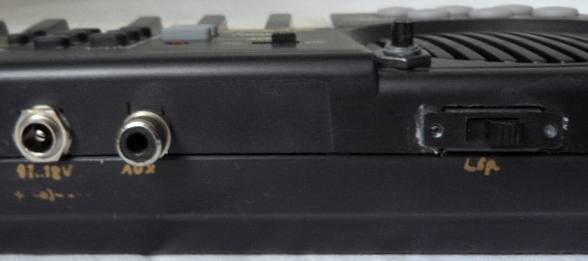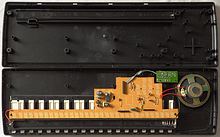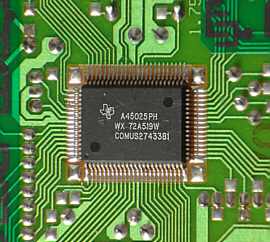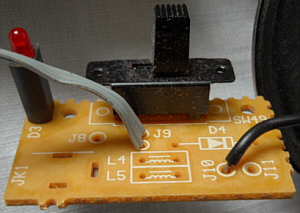|
The 6 drumpad buttons are also used as programmable chord buttons. The electronics (despite "made in Italy", not China) smelled badly of benzol-like nasty solvents; even washing the PCB in soap water didn't help. Only after 2 decades most of the odour faded away.
This keyboards was later re-released as Bontempi GT 520 and GT 510 (the latter with pretty blue case). I this keyboard was also sold under different brand names (e.g. Farfisa, Tchibo and Aldi).
 |
 |
 |
The preset sounds are quite complex and at first hear they seem to sound natural, but when listening closer, the sample based sounds are thin, noisy and a little harsh (8 bit). They seem to be made each from 2 layered waveform samples with complex envelopes and contain sustain, chorus and reverb effect those can be also manually switched on or off by numbers. (Selecting a new preset sound always switches them back to its default.) Although technically similar, the timbres are not squawky like the Casio SA-series sounds, but try hard to sound noble although partly with limited success. When not otherwise mentioned, all sounds include reverb. "Chorus" sounds (those contain 2 subvoices) half the polyphony unless the 2nd "chorus" voice is turned off. Any 2 preset sounds can be layered to achieve 666 sound combinations. The "piano" is more an e-piano, because it is made from a static waveform without chorus. "brass" is a brass ensemble. "musette" resembles a harsh accordion. "prophet" is a synth brass timbre that turns duller and brighter (wahwah chorus) while it fades silent (likely named after Prophet analogue synthesizers). The "toy piano" resembles a bright Rhodes piano (no reverb). "full organ" has a wahwah vibrato, which speed turns much slower in the bass range. "jazz organ" is rougher and harsher, and has the same wahwah vibrato. "clavinet" has here a brassy timbre with fast vibrato (6Hz, no reverb). "fifth organ" is a metal pipe organ rank chord that fades a bit duller during attack phase. "pipe" is a bright metal pipe organ rank with chorus. The "bassoon" has a slow wahwah chorus. The "mandolin" rings with a Rhodes- like timbre. The "accordion" is rather harsh. The timbre of the "harpsi" resembles a bright flute and has vibrato. "jazz guitar" is an acoustic one. "haw guitar" has a slow howling, halfway voice- like wahwah chorus effect and fast tremolo. The "jazz bass" is an e-bass with also wahwah chorus and sounds a bit brassy. The "funky bass" sounds hollow, has vibrato and resembles more a banjo. The "steel drum" sounds like made from a bright plain squarewave with chorus and percussive decay envelope (without chorus in becomes a harp). The "mute guitar" likely shall be a slightly muffled acoustic guitar (high notes resemble an e-piano). The "square" is a harsh and reedy electronic organ sound with vibrato, that resembles an accordion (with chorus off it becomes a flute). The "saw" is an even harsher and more reedy variant of this timbre (without chorus it turns brassy). The "cello" has vibrato and sounds harsh, but fairly realistic. "big ben" resembles tubular bells. "ghost" is a synth sound mixed from a fast (8Hz?) and a slow (4Hz) howling timbre that fades silent. (Both howl by about 1 semitone. Disabling chorus mutes the fast howling subvoice.) "ringing fly" is a ringing telephone bell layered with a sonorous synth piano (that has a dry multipulse squarewave timbre; disabling chorus mutes the piano). "telephone" is a electronic phone ring (a disharmonic sound made by fast toggling between 2 notes).
During rhythms the drumpads are used to play single finger chords (the set of 6 chords can be selected by entering a "chord code" number). Also without rhythm the drumpads can be used for chords by selecting any "System 5" mode besides 5 (press "system 5/ volume" and corresponding black key). The selected rhythm number here changes the chord sound. The "System 5 Plus" is a chord training feature with 5 different modes. When "rec." is selected, the power LED flashes and you can now assign chords to the 6 drumpads by playing the chord and then simultaneously pressing the drumpad it shall be assigned to. The finger combination to play chords changes (stepwise between single finger and fingered) depending on which "System 5" level number is selected. The accompaniments are unspectacular but not bad for such a small thing, although there are no fill- ins or other fancy tricks. The low- res sample percussion sounds thin and has very grainy looped hihats (nice for tekkno). The tempo can be set quite high but not very low.
The 4 demo melodies are made from a monophonic main voice (switches
among a few preset sounds) and standard accompaniment.
hardware detailsThe Bontempi GT-509 and variants are based on the single chip CPU "Texas Instruments A45025PH, ... , COMUS 2743381" (crystal clocked at 32MHz), which outputs sound through an 8-bit resistor array DAC ("8BIT 103G").
Like Casio SA-series, the sound engine is likely a single-chip softsynth. Beside internal ROM content, the CPU may be identical with the A45016PH used in Bontempi BS 2010 variants. It has 2(?) unused pins those apparently output internal state info. On my tube oscilloscope I can see something like a bit chain that varies depending on which keys are pressed (and possibly other internal register stuff). This might be an I²C bus. |
A modern successor of GT 509 is the Bontempi Genius GT 530 (only 24 preset sounds, 18 rhythms, 18 nice demos, 6 DJ samples | I own one), which wavetable main voice is only 2 note polyphonic and a polyphony bug prevents fast play. Thus the GT 509 is more interesting for making music.
This was a cheaper version of Bontempi GT 509 without drumpad buttons. Because they also act as chord buttons, in BT 304 the 6 leftmost keys are used as single finger chord section, which shortens the melody section.
This instrument was earlier released as Bontempi GT 504 and Farfisa F322, and with smaller case as Bontempi BT 604/N (shaped like their ET 202, all seen on eBay).
 |
 |
 |
 |
 |
 |
There are many bigger Bontempi and
Farfisa keyboards based
on the same "666 sounds" engine. An earlier predecessor was likely the
Bontempi
ET 202 (with nice howling synth sounds and arpeggio- like accompaniment).
A 49 midsize keys variant of the GT 509 was released as Bontempi
GT 759 (with less harsh and fatter sound but same great lo-fi zipper
noise timbres).
| removal of these screws voids warranty... | ||
 |
||
|
|